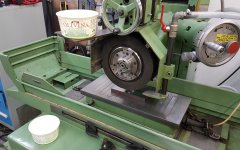Hello guys, I would just like to share with you an idea that I had in order to help me balance a wheel without an arbor and/or wheel balancer. I took 2 bowls of water, one mounted on a cantilever plate on the wheel guard and the other on the machine. I managed to substantially improve the vibration marks on the part. It's just an idea to help out. If I have more time I will come back to explain more détails on the procedure. I repair machine-tools for living so I ran quite a few grinders over the years. I wish a nice day to all my friend machinists.





